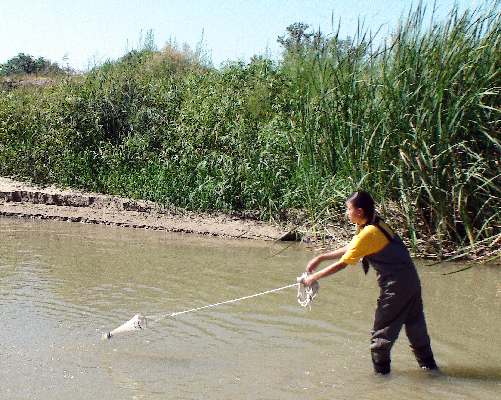Originally published January 30, 2015
By Nadia M. Whitehead
UTEP News Service
Most people don’t think twice about brushing their teeth or sipping a daily cup of joe, but these ordinary habits do more than just give you pearly whites and an energy boost.
Researchers at The University of Texas at El Paso are learning that pharmaceuticals and personal care products (PPCPs) like toothpaste and coffee can affect aquatic life too – and not in a good way.

Traces of the day-to-day products can easily end up in lakes, streams and rivers, according to UTEP biologist Elizabeth Walsh, Ph.D., who studies the impact of these environmental pollutants.
“Residuals of caffeine, medications and products like shampoo and hand sanitizer can enter the water system when you go to the restroom or take a shower,” said Walsh, a professor of biological sciences. “Wastewater treatment plants aren’t specifically designed to remove many of these compounds, so they can enter the river through water that is discharged by the plants.”
Curious to know how local aquatic life is affected by PPCPs that make their way into the Rio Grande, Walsh and UTEP students Diana Martinez and Sarah Baca investigated.
With the help of scientists at the Texas Clean Rivers Program, Martinez and Baca sampled water from the river. Donning waterproof boots, overalls and life vests, the budding researchers collected water samples they then brought back to the lab for chemical analysis.
Martinez – who now holds a master’s degree in environmental science from UTEP — collected further samples from sites along the river. The sampling spots were chosen according to their proximity to a wastewater discharge pipe. For instance, one sample was taken nearby the pipe’s outflow, while others were taken upstream and downstream from the discharge site.
As the researchers had suspected, lab tests of the samples indicated the presence of multiple pollutants, including the pain reliever acetaminophen, the antidepressant drug fluoxetine, and sulfamethazine – an antibacterial used in animal agriculture.
The team then took to the field again. This time, instead of collecting water samples, they searched for rotifers — microscopic zooplankton found in the Rio Grande and other freshwater sites.
The aquatic organisms were brought back to a lab to study how the chemicals affected their health.
“These products are so widely used by people, yet we don’t fully understand their effects on the environment,” said Baca, who now holds a bachelor’s degree in environmental science from UTEP. “I was hoping our study would help reveal their impact.”
And it did.
Over the course of several years, Martinez and Baca applied moderate to high doses of caffeine, fluoxetine, acetaminophen and triclosan – a chemical found in antibacterial products – to groups of rotifers in their petri dish homes.

“At the doses tested, almost all of these caused a significant decrease in population growth rate,” Walsh said. “Some of them caused morphological deformities at higher concentrations.”
Rotifers produced fewer eggs, and in multiple cases, their eggs even became detached from their bodies. Fluoxetine had the most detrimental effect of all four tested PPCPs.
The results confirm that PPCPs can have negative impacts on rotifers and raises concerns about potential effects on the food cycle, Baca said.
“Rotifers are an important food source for many larger animals, so if their populations decline in the wild, other animals may not get the food resources they need to survive and reproduce,” she explained.
Walsh agrees, but said more studies are needed to understand exactly what’s going on, especially studies that determine if these negative impacts are occurring in the environment. The biologist, in collaboration with chemist Wen-Yee Lee, Ph.D., hopes to soon complete a study on the Rio Grande that reveals the concentrations of these compounds in the river.
With that information, the team could conduct additional studies with rotifers under conditions that better reflect the river’s current state.